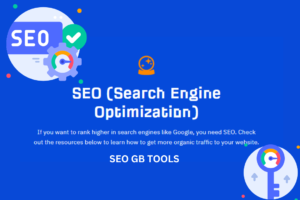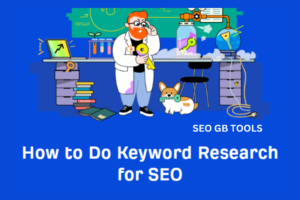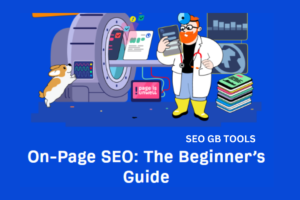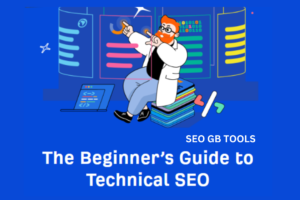In this guide, we’ll cover the SEO basics, including keyword research, on-page optimization, link building strategy and content marketing strategy. This will help you understand what it takes to get started with your own SEO campaign.

Introduction
SEO is the process of optimizing your website for search engines. It includes a variety of techniques, but first and foremost is choosing the right keywords to target so that your site shows up in relevant searches. The goal is to get more traffic from organic search results than you would have if you didn’t optimize at all, and it can be incredibly effective! (Use a tool like Ahrefs or Majestic SEO.)
This guide will cover everything you need to know about SEO: how it works, why it’s important, and how (and when) to use different kinds of on-page optimization techniques like title tags and meta descriptions. We’ll also talk about off-page factors like link building that can help boost your rankings even further by showing Google that people are engaging with content related to yours across other websites online.
What is SEO?
Search engine optimization (SEO) is the process of improving your website’s visibility in search engines, like Google and Bing. The ultimate goal of SEO is to have your website show up at the top of search results for relevant keywords, which will drive more traffic to your site.

How to succeed in SEO?
Know your audience
Be consistent in your message
Focus on quality content
1. Keyword Research
Keyword Research
Keywords are the foundation of any SEO strategy, so it’s important to do your research before diving into any other steps. Keywords are the words or phrases people use when they search for something online (e.g., “how to bake a cake”). When you know what keywords are relevant for your business and target audience, you can optimize your website pages accordingly–which will help them rank higher in search engine results pages (SERPs).

2. On-Page Optimization
On-Page Optimization
On-page optimization is all about creating a website that’s friendly to search engines, and therefore more likely to be ranked highly in the SERPs. This can be done by focusing on three main factors: keyword research, content creation and technical SEO (the latter being the least important).
The content you create should be valuable, entertaining and easy to digest. You should also make sure that it’s relevant to your audience’s interests. Once you’ve created content, promote it through social media channels like Facebook and Twitter. You can also use email marketing campaigns as a way to get your message in front of people who might not otherwise see it!

3. Technical SEO
The technical side of SEO is often referred to as “On-Page” or “Off-Page” optimization. On-page optimization refers to things that you do directly on your website and off-page optimization refers to things that you do outside of your website.
On-page optimization includes:
Titles – This is the title of your page, which should be unique for every page on your site so that if someone searches for a specific term, it will show up in the search results. It should also include keywords related to what people are searching for so they know what kind of information they can expect from visiting this page.
Meta descriptions – These are short descriptions about what each individual web page contains, like an ad copy for each individual post or article related content (such as tutorials). They appear below SERPs (search engine result pages) when someone clicks on them so make sure these descriptions are clear and concise enough so users know exactly why they should click through!
The good news is that link building isn’t as hard as it used to be. When I first started in SEO, people were buying links from directories and article sites (like EzineArticles) and using software like GSA SER to build hundreds of backlinks overnight. Things have changed since then! In this post, I’ll give you a step-by-step guide for how to build high-quality backlinks for your website.

4. Link Building Strategy
You can’t build a house without a foundation, and you can’t build an SEO strategy without links. Links are the most important part of your SEO strategy because they’re what give search engines the information they need to rank your website and determine its value.
Link building is also one of the easiest ways to improve your rankings without spending money on paid advertising, so it’s worth getting right! Use a tool like Ahrefs Group Buy or Majestic SEO.
Keyword research is the first step in any SEO campaign. It involves analyzing the top pages ranking for a given keyword and finding out what kind of content they have. You need to make sure that your website has similar content, but also something unique to offer.
5. Content Marketing Strategy
Content marketing is a strategy that uses content to attract and retain customers. It’s a great way to build trust with your audience, who will then be more likely to buy your products or services.
Content marketing can take many forms, including blogs, ebooks and videos. The goal is always the same: To create valuable content that meets your customers’ needs so they’ll come back again and again–and eventually become paying customers!
On-Page SEO is the most basic form of optimization. It is also the easiest to implement and therefore, should be your first priority if you want to increase traffic on your website.
The results show what Google thinks is the best answer to that question. If you wanted to guest post or write submissions for web design, for example, you would type “ Write for us + web design ” into Google and it would show you the most relevant links and web pages for your query about web designing guest submission accepting websites.
Why is SEO important?
Why is SEO important? Because it’s the most effective way to get your website seen by people who are looking for what you have to offer. When someone searches for something related to what you do, they’re going to find your website if it’s been properly optimized.
You can use SEO as a way of growing traffic and sales without spending any money on advertising or marketing. Once people start visiting your site through organic search results, they will stay there longer than they would if they found it through other channels like social media or paid ads (which usually require more time investment).
How to Do Keyword Research for SEO
Keyword research is a big part of SEO. It’s the process of finding out what people are searching for online, which you can then use to create content that will serve them well.
There are two main approaches to keyword research: manual and automated. Manual involves using tools like Google AdWords Keyword Planner or SEMrush (or even just your brain) to come up with long lists of related terms that you think might be relevant for your business or website. Automated takes things one step further by actually analyzing search data in real time and giving you suggestions based on actual user behavior rather than just intuition or guesswork–but it requires some initial setup work before getting started!
In this section we’ll talk about both methods so you can decide which one works best for your situation
SEO Basics Content: The Beginner’s Guide
Now that you know the basics of SEO, let’s take a look at some of the best tactics for creating content.
Create fresh content with unique information. It’s important to create new and unique content on a regular basis. If you’re going to write about something, don’t just rehash what everyone else has already said–do your research so you can provide new insights into a topic or share an experience that no one else has had yet (and make sure it’s still relevant).
Don’t forget about images! Images are extremely important for search engine optimization because they help make your website more visually appealing and engaging for readers, which will encourage them to stay longer on your site and share it with others through social media platforms like Facebook or Twitter. In addition to this benefit though, images also help improve rankings because Google interprets them as “rich snippets”–or additional pieces of information beyond just text–which increases click-through rate due to increased visibility within SERPs (Search Engine Results Pages).
On-Page SEO: The Beginner’s Guide
On-Page SEO: The Beginner’s Guide
What is On-Page SEO?
On-Page SEO refers to the optimization of your website’s content and structure. This includes factors like keyword density, keyword location and frequency, link building strategies and more. If you want to rank higher in search engines like Google then it is essential that you pay attention to these aspects of your site.
The first step to building links is knowing what a link is and how it works. A link is a reference from one website to another, usually using anchor text (text that’s underlined) or a URL. By clicking on these links, users can navigate between websites.
Link Building for SEO: The Beginner’s Guide
Link building is one of the most important aspects of SEO, but it can be difficult to know where to start.
This beginner’s guide will help you understand what link building is and how to do it effectively.
Create a high-quality website and optimize it for search engines. This will help you get more traffic from organic search results. Promote your content as much as you can on social media, email and through other channels.
If you are starting a new website, it is important that you pay attention to these factors right from the beginning. If your site is already established, then there are still things you can do to improve its SEO.
The Beginner’s Guide to Technical SEO
SEO is a technical field, and if you’re not familiar with the technical side of SEO it can be very intimidating. But don’t worry–that’s why we wrote this guide! We’re going to walk through all the different aspects of technical SEO so that you can feel confident in your ability to manage any project involving it.
The first thing we need to explain is what exactly happens when someone searches for something on Google or Bing (or any other search engine). When someone types in a query like “how do I get more traffic?” into their browser, their request goes up through layers of code until it reaches an actual computer somewhere far away from them. That computer sorts through all these requests based on what they mean and then returns results based on those meanings; these results are called SERPs (Search Engine Results Pages).
The above are the basic steps you should consider when you want to build your site’s visibility and traffic.
Optimize your site for search engines by adding relevant keywords.
Make sure that the content on your website is unique and high quality.
Create as many links from other websites as possible, but do it wisely and naturally (use a tool like Ahrefs or Majestic SEO).
Create a blog and post regular, high-quality articles. Regularly share your content on social media, but don’t spam people. Build an email list and send out valuable content regularly.
Conclusion
I hope this article has helped you understand the basics of SEO and how it can help your website. It’s not as complex as it may seem, but it does require some time and effort. If you follow these steps and continue learning about new techniques, then there’s no doubt in my mind that your site will succeed!












Leave a Reply